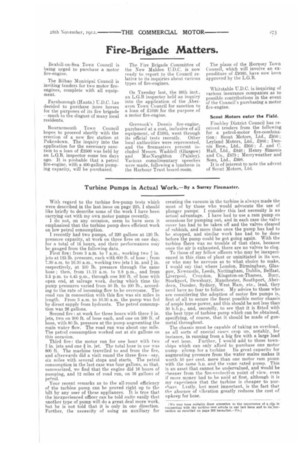Turbine Pumps in Actual Work. — By a Surrey Firemaster.
Page 9

If you've noticed an error in this article please click here to report it so we can fix it.
With regard to the turbine fire-pump tests which were described in the last issue on page 225, 1 should like briefly to describe some of the work I have been carrying out. with my own motor pumps recently. I do not, on any occasion, seem to have seen it emphasized that the turbine pump does efficient work on low petrol consumption. I recently had two pumps, of 320 gallons at 120 lb. pressure capacity, at work on three fires on one day, for a total of 16 hours, and their performances may be gauged from the following data. First fire : from 3 a.m. to 7 a.m., working two i in. jets at 125 lb. pressure, each with 600 ft. of hose ; from 7.30 a.m. to 10.30 a.m., working two jets 1 in. and .1 in. respectively, at 100 lb. pressure through the same hose ; then, from 11.12 am. to 2.8 p.m., and from 3.5 p.m. to 4.45 p.m., through one 300 ft. of hose with open end, at salvage work, during which time the pump pressures varied from 50 lb. to 100 lb., according to the rate of incoming flow to be overcome. The road run in connection with this fire was six miles in length. From 3 a.m, to 10.30 a.m. the pump was fed by direct supply from hydrants. The petrol consumption was 26 gallons.
Second fire: at work for three hours with three / in. jets, two on 200 ft.. of hose each, and one on 300 ft. of hose, with 80 lb. pressure at the pump augmenting the main water flow. The road run was about one mile. The petrol consumption worked out at six gallons on this occasion.
Third fire : the motor ran for one hour with two 5 in. jets and one / in. jet. The total hose in use was 800 ft. The machine travelled to and from the fire, and afterwards did a visit round the three fires—say. six miles with several stops and starts. The petrol consumption in the last case was four gallons, so that, summarized, we find that the engine did 16 hours of pumping, and 12 miles of road run, on 36 gallons of petrol. Your recent remarks as to the all-round efficiency of the turbine pump can be proved right up to the hilt by any user of these appliances. It is true that. the inexperienced officer can be told Quite, easily that. another type of pump will do a great deal more work, hut he is not told that it is only in one direction. Further, the necessity of using an auxiliary for
creating the vacuum in the turbine is always made the most of by those who would advocate the use of plunger pumps; I consider this last necessity is an actual advantage. I have had to use a ram pump OD occasions for pumping out, and in each case the valve cover has had to be taken off and the valves cleared of rubbish, and more than once the pump has had to be stopped, and similar work has had to be done before the pump could be got going again. With the turbine there was no trouble of that class, because once the air is exhausted, there are no valves to clog.
To those of my fellow officers who may be inexperienced in this class of plant or uninitiated in its use, or who may be nervous as to what choice to make, I would say that where London, Birmingham, Glasgow, Newcastle, Leeds, Nottingham, Dublin, Belfast, Liverpool, Croydon, Kingston-on-Thames Bury, Stockport, Dewsbury, Manchester, Southport, Aberdeen, Dundee, Sydney, West Ham, etc., lead, they need have no fear to follow. My advice to those who are considering the adoption of motor fire pumps is, first of all to secure the finest possible motor chassis, of ample horse-power, and this should be not less than 50 b.h.p., and, secondly, to see that it is fitted with the best type of turbine pump which can be obtained, specifying, of course, that it should be made of gunmetal throughout.
The chassis mnst be capable of taking an overload, as all sorts of special eases crop un, notably, for instance, in running from a big fire with a large load or wet hose. Further, I would add to those townships which can only afford to purchase one motor
pumpplump for a turbine Itri great capacity for augmenting pressure from the water mains makes it worth 50 per cent. more than one motor ram pump with the same h.p. and the same rated pumn. This is an asset that cannot be undervalued, and would be eheaper from the fire-nrotecti.on point of view, even if more money had to be paid at first, although it is my experience that the turbine is cheaper to purehase Lastly. but most. important, is the fact that the absence of vibration greatly reduces the cost of upkeep for hose.
We rnay here suitably draw attention to the occurrence of a slip in connection with the turbine-test article in our last issue and to its-correction as recorded on page 283 bereafter.—Rn.j






















